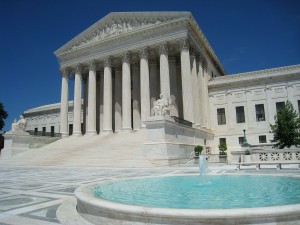Demystifying the Refine of Federal Appeals: What You Need to Know
Navigating the intricate world of federal charms can typically look like traversing undiscovered waters for those not familiar with the process. Recognizing the subtleties of appellate court jurisdiction, the intricacies of filing a notification of charm, presenting an engaging brief, and making an influential oral disagreement are crucial components that can substantially influence the result of a case. By unwinding the layers of intricacy surrounding federal allures, individuals can obtain a more clear insight into the mechanisms that govern this critical point of the legal system.
Comprehending Federal Appeals Refine
Digging right into the detailed world of the federal charms process introduces a systematic and structured trip through the judicial system. Federal charms work as a critical mechanism for evaluating choices made by reduced courts. Comprehending this process is necessary for anyone entailed in lawful proceedings at the government degree.
The procedure normally starts with an event disappointed with a lower court's judgment submitting a notice of charm. This triggers a testimonial by a higher court, where a panel of courts evaluates the lawful arguments offered by both celebrations. Briefs laying out the legal reasoning behind each event's setting are submitted, and dental arguments may be heard to make clear intricate problems.
The appellate court's choice is based upon a thorough exam of the reduced court's process and the disagreements offered. The judges do not reconsider realities but focus on whether legal mistakes took place that affected the lower court's choice. When the appellate court reaches a choice, it can verify, turn around, remand, or customize the reduced court's judgment, supplying clarity and finality to the legal disagreement. Understanding this process is vital for navigating the complexities of government charms successfully.
Appellate Court Jurisdiction Described
As we advance from recognizing the federal allures procedure to studying the complexities of appellate court jurisdiction, a basic facet comes to light concerning the authority and limitations of these greater courts in the legal landscape. Appellate court jurisdiction describes the extent of cases that a certain appellate court has the power to make a decision and evaluate upon. Unlike test courts that hear situations for the very first time, appellate courts are restricted to assessing decisions made by reduced courts. These choices can consist of judgments from both state and federal courts.
Appellate courts have territory over particular kinds of situations, normally those entailing legal mistakes, procedural concerns, or concerns of regulation instead of accurate disputes. The territory of appellate courts is normally described in statutes and regulations that govern the court system. Comprehending appellate court jurisdiction is essential for parties involved in the allures procedure as it determines whether a situation is qualified for review and the extent to which the appellate court can intervene in the lower court's decision.
Filing a Notice of Charm
The initial action in commencing the federal charms procedure involves filing a Notification of Charm with the ideal appellate court. This essential paper officially alerts the court and the various other events associated with the situation that the appealing event intends to look for a testimonial of the lower court's choice. Filing a Notice of Allure is a strict procedural requirement that sets the appellate procedure in motion.
When preparing the Notification of Allure, it is vital to guarantee compliance with the details regulations and standards of the appropriate appellate court. federal appeal attorneys. The record needs to typically include details such as the situation name, the lower court's name, the day of the judgment being appealed, and a succinct declaration showing the premises for the charm

Instruction and Dental Argument
In the appellate procedure, offering written briefs and taking part in dental arguments play pivotal duties in advocating for the appealing event's setting before the appellate court. Briefs are comprehensive legal files that describe the celebrations' debates, legal authorities, and evaluation sustaining their positions. These composed entries supply the court with a comprehensive understanding of the truths of the situation, the pertinent legislation, and why the appealing event believes the reduced court's decision must be overturned.
Following the submission and testimonial of the briefs, dental debates supply the parties an opportunity to more clarify their positions, deal with any kind of inquiries the appellate judges might have, and highlight bottom lines from their created briefs. Dental arguments are a possibility for the lawyers to convince the courts via verbal campaigning for and feedbacks to inquiries from the bench.
Both the written briefs and oral debates are essential elements of the appellate procedure, allowing celebrations to offer their instance extensively and compellingly before the appellate court. - federal appeal attorneys
Receiving the Appellate Court Choice
Upon completion of oral debates and submission of created briefs, the following critical stage in the appellate process entails awaiting the crucial ruling from the appellate court. This duration of expectancy can be loaded with a mix of anxiousness and wish for celebrations associated with the appeal. The appellate court's choice is usually provided in a composed layout and describes the court's verdicts on the legal concerns provided, the reasoning behind their choice, and the judgment provided. The time structure for obtaining the appellate court's choice can differ, however courts strive to offer prompt resolutions. Once the choice is issued, parties have to carefully evaluate the court's judgment to recognize the end result and determine any kind of more actions that may be necessary. Whether the appellate court verifies, turns around, or remands the lower court's choice, recognizing the implications of the ruling is essential for all celebrations entailed in the appellate procedure. For that reason, without delay examining and understanding the appellate court's choice is important in browsing the next action in the lawful procedures.
Final Thought
To conclude, the federal charms process is a complex however essential action in seeking justice. Understanding the appellate court territory, filing a notice of appeal, preparing briefs, and presenting dental debates are all crucial elements of this procedure. Eventually, getting the appellate court decision can offer clarity and resolution to lawful conflicts. It is crucial to navigate the government appeals process with diligence and focus to information my link to accomplish a fair end result.
As we proceed from recognizing the federal charms procedure to exploring the intricacies of appellate court territory, a fundamental element comes to light pertaining to the authority and restrictions of these higher courts in the legal landscape. Appellate court territory refers to the extent of instances that a specific appellate court has the power to determine and evaluate upon. Unlike test courts that hear instances for the first time, appellate courts are limited to assessing decisions made by reduced courts. Comprehending appellate court territory is crucial for celebrations entailed in the allures procedure as it figures out whether a case is qualified for testimonial and the extent to which the appellate court can intervene in the lower court's decision.
